Tales of Sungrazing Comets
Sungrazing Comets
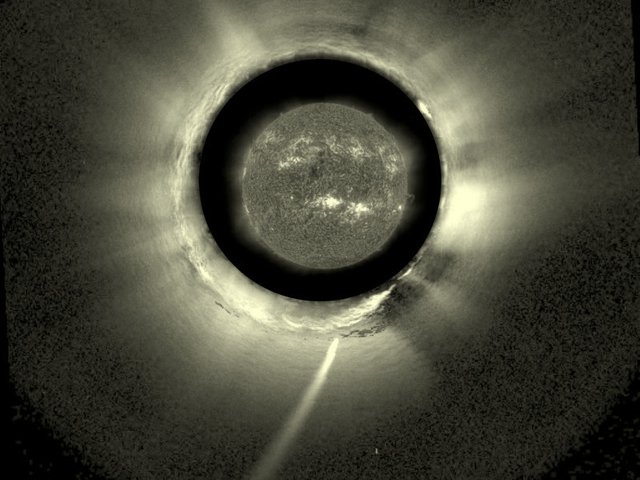
On December 16, 2011, a bright Kreutz sungrazing comet is captured approaching the sun. Image Credit: STEREO (NASA)
This article is based on a talk I plan to do at this year's Starstuff festival at Byron Bay, NSW, Australia, on July 7. If you happen to be around the area at the time, please drop by and say hello!
Introduction
Perhaps one of the most remarkable astronomical event’s is the appearance of a bright Sungrazing Comet. By definition, a Sungrazing comet is one that passes less than 0.01 Astronomical units from the center of the sun. At this distance, a comet is 100 times closer to the sun than the earth and is subjected to temperatures more than 3000 Celcius, enough to vaporize most materials. In late 2011, astronomers were able to extensively study a sungrazing comet with an estimated diameter of 0.5km as passed extremely close to the sun. The following time-lapse video shows the interaction of the comet with the sun’s inner corona.

Sungrazing Comet C/2011 W3 barely missed the sun on December 16, 2011. This animation compresses about 7 minutes into a few seconds. Observe how the sun’s intense magnetic field is guiding material from the comet. Processed from data kindly supplied by NASA/SDO and the AIA, EVE, and HMI science teams
For astronomers, a sungrazing comet is an opportunity to probe regions of the sun inaccessible by any human-made probe. In fact, NASA’s Parker probe, due to launch in 2018, will not be able to get closer to the sun than 0.04 AU, which will still incidentally subject the "Parker" to temperatures approaching 1400 Celcius! Several studies have already used observations of sungrazing comet’s to help understand the structure of the sun’s corona.
For casual sky watchers, the arrival of a bright sungrazing comet is an exciting event. Firstly, there is the dramatic development and brightening as it approaches the sun, often clearly noticeable from one night to the next. Then there is the "perihelic phase" where the comet is nearest the sun and has become so bright it can become daytime visible next to the sun, sometimes even with the naked eye. Finally, there is the large bright tail that unfurls from the comet as it moves away from the sun. A sungrazing comet looks different from other comets in that they develop long slender tails of high brightness and typically have a very small inconspicuous coma (head).
Kreutz Sungrazing Comets
Since the 1600’s more systematic and scientific records of comets started, which enabled the calculation of orbits.
Since 1680 there have been 9 bright comets observed that have sungrazing orbits computed. In the animation below these 9 orbits are plotted, and it should be quite evident that all but one of the orbits are very similar. The similarity is far too close to be a coincidence, and they are now believed to have come from the same comet that began to fragment perhaps 2000 years ago. We call these comet’s Kreutz Sungrazer’s after German astronomer Heinrich Kreutz who did extensive research on them in the late 1800’s.
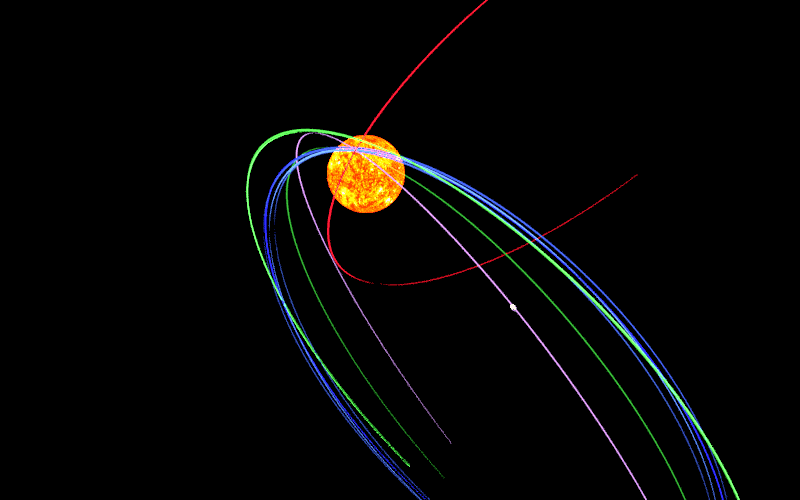
Orbital paths of all the bright Sungrazers with known orbits. All share a very close passage to the sun which is shown here as the orange globe. The one outlier is the Comet of 1680 shown here in red. Image was generated using XYZ data from JPL horizons and Blender 2.79b
Identification of an initial progenitor Kreutz comet has not been possible as records that far back are poor at best. Many cultures looked upon comet's as bad omen's and not things of scientific interest, so making useful observations of comets such as recording an accurate position in the sky was not of high priority.
The first record of a comet that has a high probability of being a Kreutz Sungrazing comet is X/1106 which appeared in March 1106. It is also significant that the calculation's show that the Sungrazing comets of 1843, 1882 and 1965 would have all been at their previous return around that time, so we can assume they were fragments of the 1106 comet. The diagram below shows one possible scenario of Kreutz comet membership4.
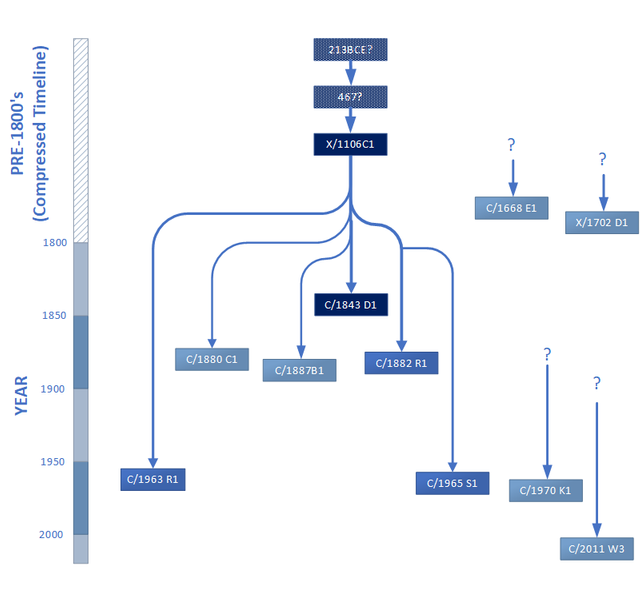
Extensive work by several investigators has started to build a picture of how the Kreutz sungrazing comet group came into existence. This diagram illustrates one such scenario, with a significant fragmentation event happening in 1106. However, the parents of the 1970 and 2011 Comets are still unknown and may have originated from an earlier fragmentation event
This model needs to address a number of problems. For instance, the origin of C/1970 K1 and C/2011 W3 is not known, and the comets of 1668 and 1702 don't have proper orbits available. In the future as more major sungrazing comet's return, this model should undergo refinement.
Comet Fragmentation
Fragmentation of comets can occur from many mechanisms, but with Kreutz comet’s, tidal and thermal fracturing are the most likely.
Tidal failure occurs as a result of differential gravity between the near and far sides of the comet when close to the sun. The Roche Limit determines the point where tidal forces exceed the self-gravity forces of a body. One characteristic of tidal fracturing in a Kreutz comet is that the fragments inherit the same orbit but return several decades apart.
Thermal fracturing is the result of heat soaking into the interior of the comet nucleus and causing expansion stresses. One characteristic of thermal fracturing is that can happen a long time after the comet has passed close to the sun. A characteristic of delayed fracturing of a comet, when far from the sun, is that the orbit of the fragments can alter quite significantly in inclination and orientation. It is likely the main reason we see the spread that we do in the orbits.
A Chronology of Kreutz Comets
The Comet of 1106
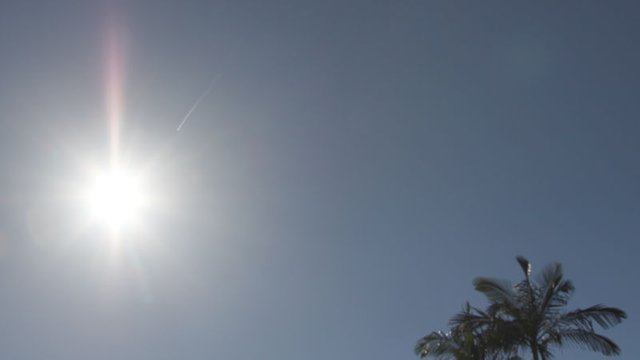
It's the middle of the day, and a sungrazing comet approaches the sun from the upper right. This is possibly what observers saw in late February, 1106. The comet image has been added artistically and is based on the author's experience of bright comets and eye witness reports of Sungrazing comets
In February 1106, people throughout the world recorded the apparition of a bright comet. Although most reports were of a "terrible, or awful, tailed star" a couple of writings do tell of its location in the south-western sky below the constellation of Orion. Additionally, some reports indicated that for a time it was visible in the daytime near the sun. This information is consistent with a Kreutz Sungrazing comet appearing at this time of year. Although this alone is not conclusive, it is interesting to note that previous returns for 1843, 1882 and 1965 comets all point back to close to this year. All of these points gives us further confidence that the 1106 comet was indeed a Kreutz Sungrazer.
Sungrazing Comet of 1843
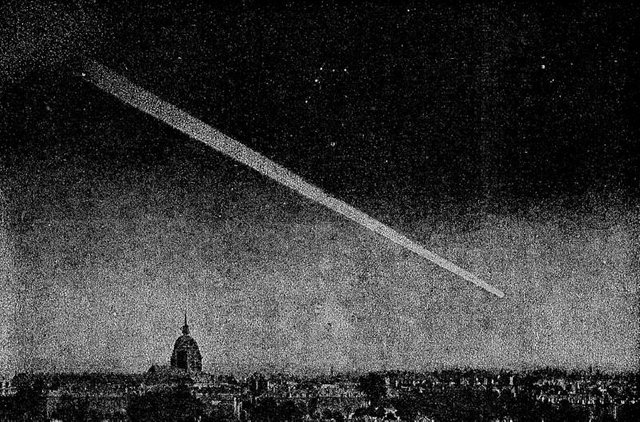
Image credit : W. Valentiner: "Das Wissen der Gegenwart, 27. Band: Kometen und Meteore" (Copyright expired)
Early in February 1843, reports started to appear of a bright comet very low in the evening sky. Communications were slow in those days, the news did not travel quickly, but more and more people started to notice the brightening comet. By February 27, newspapers indicated there were widespread reports of a bright comet next to the sun during the daytime. Chinese records also make mention of a large "broom star" being visible during the daytime on February 28.
Starting from March 1, 1843, the comet's bright tail was observed extending out from the evening twilight. For the first few weeks of March 1843, the comet dominated the evening sky casting a long, brilliant thin tail at a distance of about 45 degrees (i.e., halfway from the horizon to directly overhead). Some historians consider this comet to be the most spectacular comet in the past 200 years, on account of not just the length of the tail but also the brightness of the tail.
Observations of the comet confirm it to be a Kreutz comet, and there are reasons to believe it is the primary returning component of the 1106 comet mentioned above. Firstly, a recent re-examination of observations indicates a previous return around that time. Secondly, to this day there is a constant train of small Kreutz fragments visible in satellite imagery that concentrates along the orbit of 1843 D1, which suggest's this is where most of the mass is located.
Sungrazing Comet of 1882
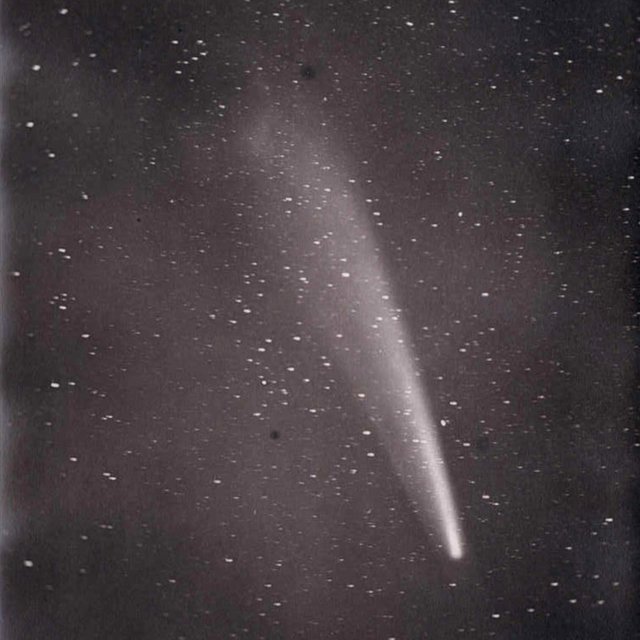
David Gill's historic photograph of Comet C/1882 R1 was obtained on November 7, 1882. This was the first comet of which we have good photo's of
Perhaps the most famous Kreutz Comet is the Great Comet of September 1882 which became a striking sight in the morning sky for several months. At it's closest approach to the sun on September 17, 1882, it became so bright that astronomers could directly observe the comet's head right up to the edge of the sun (they were using heavily filtered telescopes). At this time it was also plainly visible to the naked eye in the middle of the day.
Apart from being impressive to look at the comet also split into at least 6 pieces, the first of which is predicted to return around 2487AD, and the others will follow over a period of 150 years.
Another interest fact about this comet it was the first to have good photographs taken. Her Majesty's Astronomer David Gill based near Capetown in South Africa succeeded on several occasions. One of his images, from November 7, 1882, is shown above. David Gill also gives this beautiful account of the comet rising just above the sun on the morning of September 18, 1882.
The following morning, at Simon's Bay, I was astonished at the brilliancy of the comet as it rose behind the mountains on the eastern side of False Bay. There was not a cloud in the sky, only a merging into a rich yellow that fringed the blackish blue of the distant mountains, and over the mountains and amongst the yellow and ill-defined mass of golden glory rose with a beauty I cannot Describe.
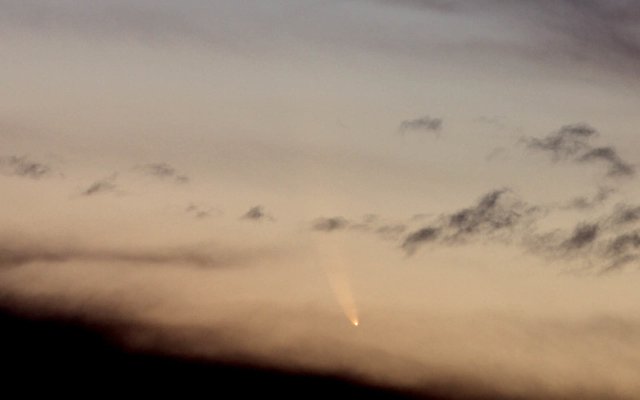
This image is possibly similar to the scene David Gill saw, although it is actually another comet, McNaught's in 2007
The sun rose a few minutes afterwards, but to my intense surprise the comet seemed in no way dimmed in brightness, but instead becoming instead whiter and sharper in form as it rose above the mists of the horizon.
Sungrazing Comet of 1965
Comet C/1965 S1 (Ikeya-Seki) was a comet found in September 1965 and is the brightest Kreutz Sungrazer of modern times. Like C/1843 D1 and C/1882 R1, it became very bright and could be briefly seen with the naked eye in the daytime next to the sun. One Australian watched the comet throughout the day using nothing more than welder's goggles!
It subsequently moved into the morning sky where it skywatchers across the world saw quite a spectacle. I remember my father described to me as being like a large luminous feather in the sky. Comet Ikeya-Seki was seen to split into 2 fragments that should return sometime around the 28th century.
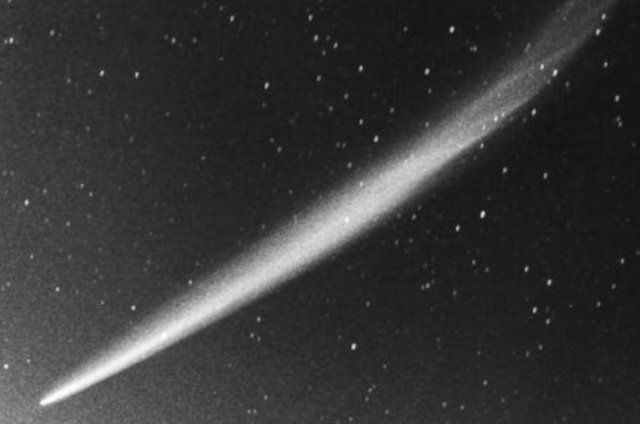
James Young got this great image of Comet Ikeya-Seki on October 1965
Note: copyright prevents me from posting some of the better images of Comet Ikeya-Seki, so make sure you do a search for some of the wonderful images online! Try Here
Sungrazing Comet of 2011
The author found this comet on November 27, 2011, as a very faint glow in the constellation of Centaurus. A few days later an orbit was computed that indicated it was a Kreutz comet, the first bright Kreutz comet seen from the ground since 1970. The orbit is noticeably different to previous Kreutz comets and may be an of another clump or cluster of sungrazers that didn't originate from the 1106 comet.
As it turned out this comet, designated C/2011 W3, was of an intermediate size which meant that it did not survive its encounter with the sun, but still developed a sizeable bright tail that persisted for several weeks.
It was also extensively observed from space which was a first for a Kreutz comet of this size.
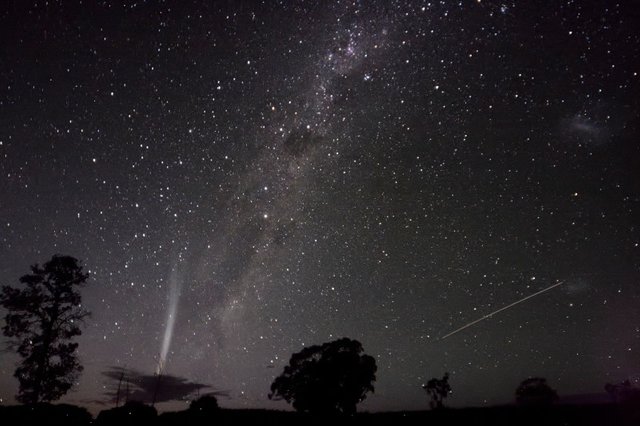
The author got this image on Christmas Eve, 2011, from near Miles, QLD. Comet C/2011 W3 rises at the left and the International Space Station leaves a trail in the lower right.
There are some really great images online for this comet, have a look here and here for example.
Mini Kreutz Comets
We've looked at the really showy examples of Sungrazers, which are rare, but solar observing satellite's like "The Solar and Heliospheric Observatory" and STEREO actually detect small Kreutz fragments on an almost daily basis. To date at least 3000 fragments have been found as part of a citizen science effort to closely monitor realtime images from these satellites. Not one of these objects has been observed to survive their encounter with the sun.
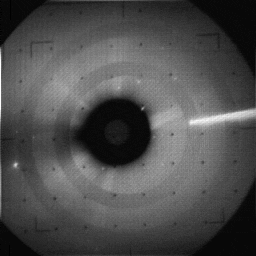
The first Kreutz comet to be found by satellite was from August 30/31, 1979, when Comet C/1979 Q1 (SOLWIND) was imaged by the SOLWIND P78-1 Satellite using its solar coronagraph. This footage compresses about 19 hours into a few seconds. The orbit was not accurately determined; however, it seems it did contact the sun resulting in its immediate destruction and only a faint debris surviving. Venus is the starlike object on the left, and the sun hides behind the black occulting disk at the center. Image Credit: NASA/NRL
Conclusion
There is no reason to think that there won't be more bright Kreutz Sungrazing comets in the future, maybe even the near future. The appearance of the 2011 comet may signal the return of another cluster of Sungrazing comets in the coming decades.
References
Marsden, B. G. "The Sungrazing Comet Group." The Astronomical Journal 72 (1967): 1170. doi:10.1086/110396.
Kronk, Gary W. Cometography: A Catalog of Comets. Cambridge, U.K.: Cambridge University Press, 1999.
Sekanina, Zdenek, and Paul W. Chodas. "Fragmentation Hierarchy of Bright Sungrazing Comets and the Birth and Orbital Evolution of the Kreutz System. I. Two‐Superfragment Model." The Astrophysical Journal 607, no. 1 (2004): 620-39. doi:10.1086/383466.
Sekanina, Zdenek, and Paul W. Chodas. "Fragmentation Hierarchy of Bright Sungrazing Comets and the Birth and Orbital Evolution of the Kreutz System. II. The Case for Cascading Fragmentation." The Astrophysical Journal 663, no. 1 (2007): 657-76. doi:10.1086/517490.
Sekanina, Zdenek, and Paul W. Chodas. "A New Orbit Determination for Bright Sungrazing Comet of 1843." The Astrophysical Journal 687, no. 2 (2008): 1415-422. doi:10.1086/592081.
Sekanina, Zdenek, and Rainer Kracht. "Population Of soho/stereo kreutz Sungrazers And The Arrival Of Comet C/2011 W3 (Lovejoy)." The Astrophysical Journal 778, no. 1 (2013): 24. doi:10.1088/0004-637x/778/1/24.
Sekanina, Zdenek, and Paul W. Chodas. "Comet C/2011 W3 (Lovejoy): Orbit Determination, Outbursts, Disintegration Of Nucleus, Dust-Tail Morphology, And Relationship To New Cluster Of Bright Sungrazers." The Astrophysical Journal 757, no. 2 (2012): 127. doi:10.1088/0004-637x/757/2/127.
NOTE: All images are the author's unless otherwise noted

I've bagged 4 or 5 comets over the years, but I took a long hiatus from observing starting several years ago and just ending a few months back. I have my observing mojo back and dusted off my gear. So, of course, it's been rainy and cloudy most nights since then then. I need to go back and check my old observing logs, but I think I have seen one of the comets you discovered. I forget which one, but it would have been back between 2004 and 2010 or so.
Its good to hear your back up running. If the Lovejoy comet you saw was between 2004 and 2010 it would have been C/2007 E2.
Impressively detailed and very informative post. I would be curious to know how many more passages the sungrazing fragments will survive as I assume they lose large quantities of mass with each passage, right ? One would expect them to evaporate more or less completely after a number of sungrazing passages
What we don't know is how many large fragments there are still out there, that is the big question. There is no question fragmentation started earlier than 1106, since there are objects that can't be connected back to that year. So I'd say there are more 1882/1965 comet's in the pipeline. What seems to happen is once the fragment gets down below 0.3-0.5km it is destroyed by the sun.
What a great article to read during a tea break Terry 😊 Of course, this is all new information for me, and I found it fascinating :)
Ps: I love the images you selected to ilustrate this post.
Take care and have a wonderful week.
Thank you @abigail-dantes, I''m really glad you liked the images! I find it fascinating these objects are the same as what are medieval ancestors saw.
Another super interesting post. I would like to see more comets. They don't even have to be sungrazing. I'd be happy with just the regular ones!
I'll see what I can do! I have some incredible images from some other people, just need to get the permission to post :)
Wonderful work @terrylovejoy, I never knew anything about sungrazing comets so thanks for the education. It is mind blowing how components of the same comets keep showing up, even hundreds of years later.
Once again the images rock! Great skills!
Keep it up!
Thank you!
I had no idea that that was an observable effect. Very cool and useful.
Yes it was very cool!
Fantastic post. Great information.
Was Halley considered a sungrazing comet?
No Halley's closest approach to the sun is 0.59 AU (90 million km) whereas these sungrazers get within about a million km.
A great article. I try to follow the brighter comets appearing in our sky in visual observations in my 12'' dobsobian.
Usually there is a few comets around you can hunt down with a 12. Next bright-ish one is probably 46P/Wirtanen later this year.
Great article Terry!
And congratulations for discovering Comet C/2011 W3, even if you heard it a thousand times :-)
Thank you Kevin!
Hi! This is jlk.news intelligent bot. I just upvoted your post based on my criteria for quality. Keep on writing nice posts on Steemit and follow me @jlkreiss to get premium world news updates round the clock! 🦄🦄🦄